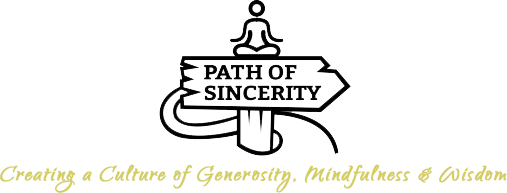 There are two basic ways to practice eating meditation.
There are two basic ways to practice eating meditation.
The first is about being mindful of your sensory experience.
Before the food even goes into your mouth, you take a moment to really look at it. You put your nose to it, and smell its various fragrances. Maybe you even feel it in your hands.
Once you place it in your mouth, you direct all your attention to the sensory experience of eating. You notice the textures and flavors. You notice what it’s like to chew or swallow. You tune into whether or not you find this food pleasant, unpleasant or neutral. You feel your mouth and tongue, and how it changes from bite-to-bite.
You could use gentle mental labels to help with this, such as soft, bitter, pleasant, sour, crunchy.
Lots more could be said, but most everything you’ll read about mindful eating focuses on the above, so today I’ll spend more time on the second approach.
 The second is about being mindful of the mind.
The second is about being mindful of the mind.
Personally, I’ve found this one to be considerably more transformative, and today I’ll share a method of practicing it that I do at least once a day. Sometimes I call it “gap-centered eating.” Here are the basic instructions:
Immediately after putting food in your mouth, put your utensil or eating object (i.e. your banana) back on the table. Rest your hands in your lap and do not remove them until you have swallowed the previous bite AND waited at least a few seconds (i.e. one breath).
And what exactly is the point of this?
The primary purpose of meditation is to notice and break free from our reactivity and autopilot living.
With “gap-centered eating,” most people find that their mind does not want to stay with this practice for an entire meal.
Instead, it wants to hurry. As soon as one bite has lost most its flavor, it wants to experience the next bite. Even more so, the mind doesn’t want to stay present for something as mundane as eating—it wants to wander off into past, future and fantasy.
And, what’s more is that these habits of the mind are happening all day long!
Rather than stay present with our life, our mind constantly seeks the next pleasure or excitement, and prefers the numbed familiarity of thought to the vibrancy of the present.
In other words, by inserting a gap you have the chance to notice your constantly-happening reactivity and autopilot habits.
You’ll notice all your little cravings, urges and impulses; like to have the next bite, to hurry, to fidget, to get away, or think about something more exciting. You’ll also start to notice your aversion to doing the practice itself. You’ll likely notice some really convincing thoughts & feelings that will try to tell you, “I understand the point of this exercise, so now I don’t have to do it anymore.”
The more deeply you can notice these habits, the more you have the opportunity to break free from them.
As some part of you already knows, the taste of freedom is joy and connection—much more delicious than a thousand & one ripe strawberries!
Is that really all there is to do—just insert gaps?
If you like, you can also pay attention to the sensory experience of eating, or to sounds, body sensations or anything else—whatever helps you stay grounded in the present, and keep inserting one gap after another.
However, once again, the point of the gaps is primarily to get you to notice and study your mind. An attitude of curiosity and perseverance is really the most important thing.
 A final note on both practices of mindful eating
A final note on both practices of mindful eating
Over years of practicing mindful eating, I’ve found one other component to be absolutely essential: intention.
If I just willy-nilly try and do a little mindful eating, it usually doesn’t last very long. However, if at the beginning of the meal, I take a moment of stillness, and make an active decision to practice mindful eating for the entire meal, then I pretty much always follow through on that decision.
In other words, if you set your intention to do these things, then when all the mental reactivities and autopilot tendencies inevitably come up, you’ll have it in you to keep re-directing back to your intention, back to mindful eating.
Ultimately, mindful eating is just as powerful as sitting meditation, walking mediation or any other form of meditation.
Study your mind and set yourself free!

Another great article David! I’ve practiced mindful eating, especially gap-centered earring, before but this inspires me to do more. I can see how eating with intention can help set the focus and be more successful.
Thank you